Former U.S. President Donald Trump set off alarm bells in Europe when he told a campaign rally that he would encourage Russia to “do whatever the hell they want” to any countries he judged to be delinquent on their defense obligations. European countries were already fretting about the possibility of a second Trump term, and these latest remarks sent these concerns into high orbit. European Commission President Ursula von der Leyen told the Financial Times a few days later that Europe was facing a world “that has got rougher” and that “we have to spend more, we have to spend better, and we have to spend European.”
But the question remains: Will Europe do enough to be able to defend itself? Complaints that European states are overly dependent on U.S. protection and unwilling to maintain adequate defense capabilities have a long history, and the wake-up call provided by Russia’s invasion of Ukraine in 2022 has yet to produce a dramatic increase in Europe’s usable military power. Yes, NATO members are now spending more money and the EU recently authorized an additional 50 billion euros in financial support to Ukraine. But Europe’s ability to maintain substantial forces in the field for more than a few weeks remains paltry: It still relies on the United States for some critical capabilities, and some NATO members have reason to wonder if their partners could do much to help if they were attacked, even if those partners tried.
To be sure, rhetoric from European officials is becoming more strident. Danish defense minister Troels Lund Poulsen recently warned that Russia might test the NATO mutual defense clause “within three to five years,” and another senior NATO diplomat believes we no longer have “the luxury to think that Russia would stop with Ukraine.” According to another senior diplomat, Russia’s “intent and capability” to attack a NATO country by 2030 was “pretty much consensus” within the alliance at this point. Because it might take Europe 10 years or more to develop sufficient capabilities of its own, diehard Atlanticists want to keep Uncle Sam firmly committed to Europe despite all the competing demands on U.S. time, attention, and resources.
Can Europe get its act together? Two well-established bodies of theory are relevant here. The first, to which I have tried to contribute, is balance of power (or if you prefer, balance of threat) theory. It predicts that a serious external threat to European security—such as a nearby great power with a strong military and highly revisionist ambitions—would cause most of these states to join forces to deter the threat (or if necessary, to defeat it). That impulse would grow stronger if these states understood that they could not rely on anyone else for protection. Recent increases in European defense spending and Sweden and Finland’s decisions to join NATO illustrate the tendency for threatened states to balance perfectly, and this well-established tendency should make us more optimistic about Europe’s ability and willingness to take greater responsibility for its own defense.
Unfortunately, a second body of theory makes that upbeat outcome less certain. Because security is a “collective good,” states in an alliance will be tempted to “buck-pass” or free-ride on the efforts of others, in the hope that their partners will do enough to keep them safe and secure, even if they do less. This tendency helps explain why the strongest members of an alliance tend to contribute a disproportionate amount to the collective effort. If an alliance’s leading members do enough to deter or defeat an attack, the contributions of the smallest members may be superfluous. After all, the alliance wouldn’t be that much stronger even if they doubled their efforts. Hence the temptation to do less, confident that the larger actors will do enough out of their own self-interest. If enough members succumb to the temptation to let others bear the greater burden, however, or if other selfish interests overcome the need to work together, then the alliance may not produce the combined capabilities and coordinated strategy it needs to be secure.
Taken together, these two well-known theories underscore the dilemma NATO faces today. The good news is that NATO’s European members have vastly more latent power potential than Russia does. They have three to four times more people, and their combined economies are a whopping 10 times larger than Russia’s. Several European states still have sophisticated arms industries capable of producing excellent weapons, and some of them (e.g., Germany) possessed formidable ground and air forces during the latter stages of the Cold War. Even more remarkably, NATO’s European members alone spend at least three times more on defense than Russia does every single year. Even if we allow for higher personnel costs, duplication of effort, and other inefficiencies, Europe has more than enough power potential to deter or defeat a Russian attack, assuming that latent capacity is properly mobilized and led. And the Russian military is not a colossus: Although its military performance and defense production capacity have improved significantly since the onset of the Ukraine war, it has had a hard time overcoming the less numerous and less well-armed Ukrainians. An army that takes months to seize Bakhmut or Avdiivka is not about to launch a successful blitzkrieg against anyone else.
The bad news is that a sustained effort to mount a capable European defense force faces significant obstacles. For starters, NATO’s European members do not agree on the level or even the identity of their main security problems. For the Baltic States and Poland, it is obvious that Russia poses the greatest danger. For Spain or Italy, however, Russia is a distant problem at best and illegal migration is a bigger challenge. Unlike some analysts, I don’t believe this situation prevents Europe from mounting an effective defense against Russia, but it does make issues of burden-sharing and military planning more complicated. Getting Portugal to do much to help Estonia will take a bit of persuasion.
Second, those who want Europe to do more face a delicate dilemma: They must convince people there’s a serious problem, but they also have to convince them that solving the problem won’t be too costly or difficult. If they try to mobilize support for a big defense buildup by exaggerating Russia’s military capabilities and portraying Vladimir Putin as a madman with unlimited ambitions, the challenge Europe appears to face might seem insurmountable and the temptation to fall back on Uncle Sam will grow. But if Russia’s power and ambitions are believed to be more modest and therefore manageable, it will be harder to convince European publics to make big sacrifices now and to sustain a serious effort over time. To make greater autonomy work, Europeans must believe that Russia is dangerous, but they must also believe they can handle the problem even if the United States does significantly less. For this reason, claiming that it is simply impossible for Europe to defend itself on order to keep the United State fully committed might be counterproductive, if it discouraged a serious European effort and the United States reduced its commitment anyway.
A third obstacle is the ambiguous role of nuclear weapons. If you really believe that nuclear weapons deter large-scale acts of aggression, then you’re likely to think that the British and French nuclear forces and the American “nuclear umbrella” will protect NATO from a Russian attack under almost any circumstances. (Ukraine, it is worth remembering, is not a NATO member.) And if so, then there’s less need to build a big and expensive array of conventional forces. If you’re not that confident about the reliability of extended nuclear deterrence, however, or you don’t want to have to threaten nuclear use in response to some low-level challenge, then you’ll want the kind of flexibility that capable conventional forces provide. This issue was a point of contention within NATO throughout the Cold War, as the intra-alliance debates over “Flexible Response” in the 1960s and the “Euromissiles” controversy of the 1980s showed. The issue remains relevant today, insofar as the continued presence of nuclear weapons may tempt some states to let their conventional forces languish.
Fourth, European states still prefer to invest in their own defense industries and armed forces, instead of cooperating to standardize weaponry and develop a common strategy and defense plans. According to a 2023 report by the Center for Strategic and International Studies, although overall European defense spending has risen sharply since Russia seized Crimea in 2014, the percentage devoted to cooperative procurement efforts fell steadily until 2021 and never came close to the 35 percent target previously set by the EU. EU countries reportedly field some 178 different weapons systems—148 more than the United States—despite spending less. The stubborn tendency to go it alone squanders the enormous latent resource advantage that Europe enjoys over possible challengers and may be a luxury it can no longer afford.
A final obstacle—at least for the moment—is America’s long-standing ambivalence about encouraging Europe to stand on its own. The United States has generally wanted its European partners to be militarily strong—but not too strong—and politically united—but not too united. Why? Because this arrangement maximized U.S. influence over a coalition of capable but subordinate partners. Washington wanted the rest of NATO to be strong enough to be useful but also fully compliant with U.S. wishes, and compliance would be harder to maintain if these states became stronger and started to speak with one voice. The desire to keep Europe dependent and docile led successive U.S. administrations to oppose any steps that might have led to genuine European strategic autonomy.
Those days may be coming to an end, however. One need not be Trumpian to recognize that the United States “cannot have it all” and that it needs to shift more of the burden of collective defense onto its European partners. But if the past is any guide, Europe will not pick up the slack if its leaders are still convinced that Uncle Sam will be “all-in” under any circumstances. It is worth recalling that the initial push for European economic integration in the early 1950s was driven in part by European fears that the United States was eventually going to withdraw its forces from the continent and that their ability to counter the Warsaw Pact would be enhanced by the creation of a large and unified European economic order. The security impulse behind European integration receded once it became clear that Uncle Sam was staying, but growing doubts about the U.S. commitment would give Europeans ample incentive to mobilize their superior economic capacity and latent military potential more effectively, purely out of self-interest.
U.S. officials should encourage this development, regardless of who ends up in the White House next year. As I’ve argued before, the process of turning European security back over to Europeans should be done gradually, as part of a new transatlantic division of labor. Reduced reliance on the United States will lead Europe to balance more vigorously, and moving slowly but steadily in this direction will give our allies time to overcome the dilemmas of collective action that will inevitably arise. Because the nations of Europe have considerably more military potential than Russia does, they need not do this perfectly in order to be pretty darn safe.
 Eurasia Press & News
Eurasia Press & News




